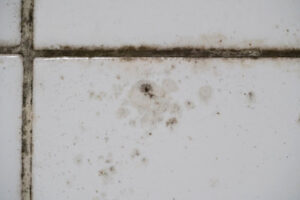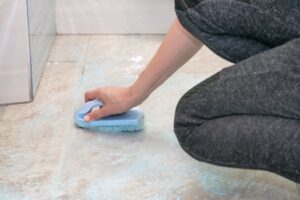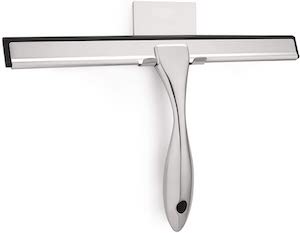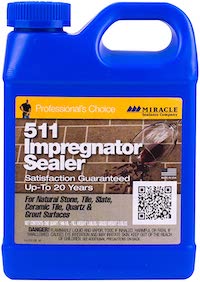Regardless of how clean you keep your home, mold seems to find a way to appear at the most inconvenient of times. Maybe you are trying to enjoy a relaxing bath only to notice mold popping up along your grout lines. Or maybe you are preparing your bathroom for your in-laws’ visit when you discover a nice little area of mold forming by the sink. Fortunately, there are several ways to easily and effectively clean grout in your shower or bathroom, eliminating mold and leaving behind a clean surface.
How can you clean grout? There are many methods you can use to clean the grout in your bathroom. The most common route is to use a toothbrush with a small amount of a cleaning agent such as distilled white vinegar, baking powder, or bleach to get in the porous groves created by grout. If your grout requires additional cleaning, there are several more advanced solutions for removing nasty mold once and for all.
The appearance of mold can quickly discourage your house cleaning efforts and lead you to believe that you are living in a nasty abode. Unfortunately, the warm, humid environment of the bathroom is a breeding ground for mold. However, with the right tools and preventative measures, you can remove the mold in your bathroom, leaving behind clean grout!
In this post, we will take a look at why mold is commonly found growing on the grout in even the cleanest bathroom. We will also share a few professional recommendations for cleaning products to use as well as preventative measures to eliminate the spread of mold. Equipped with this knowledge, you can establish a cleaning routine that prohibits mold from taking over the grout in your shower and bathroom.
Complete Guide to Removing Mold from Shower & Bathroom Grout
When you notice the first signs of mold growing on the grout in your bathroom or shower, you are likely to feel as if it is a losing battle. However, there are many steps you can take to easily and effectively clean your grout, removing mold in a matter of minutes.
What is Grout?
If you have any type of tile work in your bathroom or shower, you also have grout. Grout is a highly-porous material made of a mixture of water, cement, and sand. It is used to fill gaps between tiles and seal the joints that naturally exist in a tiled area. While grout is essential to preventing damage to the wall behind the tile in your bathroom, it requires a bit of additional care and attention.
Why does mold grow on grout?
Whether you maintain a regular bathroom cleaning routine or not, you may be confused to find mold growing on your grout. There are several reasons why mold grows so easily on bathroom and shower grout. This is a normal occurrence for virtually every home and is not something that should cause embarrassment or shame! A bathroom’s warm and humid conditions encourage mold growth. Simply put, bathrooms are a prime breeding ground for mold and fungus. Mold grows best in warm, humid conditions – a perfect description of nearly every bathroom. While many bathrooms are outfitted with an exhaust fan, it is often not utilized properly. Additionally, poor ventilation or bad cleaning habits can accelerate the growth of mold on the already porous surface of your grout.
In addition to having an environment that is ideal for mold growth, grout is naturally a very porous material. When water sits on the surface of the grout for extended periods of time, mold quickly begins to form. Certain types of grout are made to be mold-resistant. Unless you build your home or remodel your bathroom, however, you are unlikely to have this type of grout in your shower.

Why Do You Need to Clean Mold From Bathroom & Shower Grout?
So, is it really that important to clean the grout in your shower and bathroom? Does mold make that big of an impact or should you keep the grout clean simply for aesthetic reasons? There are actually several reasons why it is important to stay on top of the mold growth that so quickly accumulates on the grout in your bathroom and shower.
1. Moldy Grout Makes Your Bathroom Look Dirty
Quite frankly, moldy grout instantly makes your bathroom look dirty. While this may be something that you can overlook day after day, your visitors are likely to notice it instantly. Additionally, it is always easier to clean your grout regularly as opposed to waiting until the mold becomes a serious problem requiring professional intervention.
2. Moldy Grout Compromises the Integrity of Your Home
Unfortunately, mold growing on your grout can quickly compromise the integrity of other areas of your bathroom. In doing so, it compromises the integrity of your home as a whole. There are countless reasons why you should prevent and eliminate mold growing in your home at all costs. A few, however, include the safety of your family and the resale value of your home.
3. Moldy Grout May Impact Your Health
Many people have sensitivities to mold. Spending time in a bathroom that has mold growing on the grout can negatively impact their health to varying degrees. It is important to clean the grout in your bathroom and shower, removing any mold, to ensure that you and your family remain safe and healthy.
Best Products for Cleaning Mold on Shower & Bathroom Grout
There are countless ways to clean the grout in your shower and bathroom. The method you use will depend largely on personal preference as well as the severity of the mold growing on your grout. In some cases, you may not need anything other than an old toothbrush and soap. There are, however, several other products that you can use to clean your grout.
Most of these methods work best when applied with an old toothbrush or a small cleaning tool with stiff bristles. This will allow you to truly scrub the mold from the surface of the grout.
 1. Distilled White Vinegar
1. Distilled White Vinegar
Believe it or not, distilled white vinegar is actually one of the most versatile cleaning products in your home. A non-toxic solution that works to quickly remove mold from your grout, vinegar can be diluted with water or used straight out of the bottle.
Many homeowners dislike the scent of white vinegar. It is, however, a great way to clean the surfaces of your bathroom, including the grout! Vinegar is best applied to grout with a spray bottle. Once the grout is saturated, allow the vinegar to sit for up to 30 minutes. Once the time is up, remove it with a damp sponge. You can also use an old toothbrush or bristle brush to really clean the areas of grout between each tile.
2. Borax
Borax is one of those household cleaners that seems to have been around forever. It is no less useful now than it was decades ago! Borax is a white mineral powder that is diluted in warm water. Like white vinegar, it is easiest to apply Borax using a spray bottle. Let sit for several minutes before using a sponge or brush to finish cleaning the grout.
Borax is also a natural cleaning agent! Because of this, it is safe to use on the other surfaces of your bathroom as well as the grout!
3. Bleach
Although it is important to exercise caution when cleaning with bleach, it can be an incredibly effective cleaning agent for moldy grout. You must dilute the bleach before using it to clean. Most professionals recommend a ratio of 1:4 bleach to water for bathroom cleaning. Bleach should never be used to clean porous surfaces such as ceilings or walls. It is, however, incredibly effective for cleaning less porous surfaces such as grout, tile, tubs, toilets, and showers. If you choose to use bleach to clean your grout, be sure to rinse the area thoroughly with water to avoid damage to your skin, clothing, or other surfaces during your next shower.
4. Baking Soda
Almost everyone uses baking soda around their house for one thing or another. But did you know that baking soda can be used to clean the grout in your bathroom and shower? While it is not as effective as bleach or other chemical cleaners, baking soda is an effective way to eliminate mold from your grout.
Baking soda can be diluted in water and applied to the affected areas with a spray bottle. Many people, however, choose to make a paste that can be applied directly to the mold grout. This is best accomplished with an old toothbrush to target the areas of mold growth.
Regardless of your chosen application method, let the baking soda solution sit for up to 30 minutes before removing it with a damp sponge, toothbrush, or bristle brush.
5. Salt
Salt is also surprisingly effective at removing mold from grout in your bathroom. The difference between using salt and other solutions such as baking soda is that the grout must be wet before the salt is applied. Simply sprinkle salt on the areas of mold and then use an old bristle brush to scrub it into the grout.
Allow the salt to sit for up to 12 hours before using water to rinse the surface. Because this method requires the salt to sit on the mold for such a long period of time, it is not the best solution for cleaning grout along the walls of a shower.
6. Hydrogen Peroxide
Hydrogen Peroxide appears as a whitening and cleaning agent in everything from toothpaste to household cleaners. It is no surprise that it works to rid bathroom grout of mold! Hydrogen peroxide works to clean the grout, leaving it white and free of mold. It also acts as a fungicide, removing even invisible mold spores.
Hydrogen peroxide can be used in the same way as many other cleaning solutions on this list. Either apply the hydrogen peroxide using a spray bottle. Or, for more effective results, make a paste by combining hydrogen peroxide with either flour or baking soda. Apply this paste directly to the grout using a toothbrush for truly astonishing results.
Other Mold Removal Products & Tools
Of course, there are countless other mold removal products from cleaning agents to high-powered scrubbing machines. You likely have one, or several, of the natural solutions already within your home. Because of this, it is recommended that you begin the cleaning process using one of the methods mentioned above. If, however, you find that you are needing a stronger solution, be encouraged that there is sure to be a product on the market for you!
Precautions to Take When Cleaning Mold in Bathroom or Shower
Whenever you are dealing with mold removal, especially in a closed area such as a bathroom or shower, you must take the necessary precautions.
1. Ensure Proper Ventilation While Using Cleaning Products
Proper ventilation is of the utmost importance when dealing with mold or strong cleaning agents. If you are able, open any windows and doors in the bathroom to ensure ventilation. Always use the exhaust fan during and after your cleaning process. If the bathroom does not have an exhaust fan, it may be wise to use a small fan to direct airflow out of the bathroom.
Here is our article on installing a bathroom ventilation fan.
2. Wear Protective Gear Including Gloves & Glasses
When you are working with any type of strong cleaning agent, it is important to use protective gear. Especially for things such as bleach, it is important to wear protective gloves, glasses, and even a ventilation mask.
3. Test Cleaning Products on Small Area Before Beginning Project
If you are using a new cleaning method to clean the grout in your bathroom, first test the cleaning product on a small, hidden area. Grout that is painted or treated may react negatively to a cleaning agent, leaving behind a visible stain or mark.
4. If You Suspect Black Mold, Consult a Professional
Most mold that grows in a bathroom is harmless. Black mold, however, is something that should only be handled by a professional mold removal team. If you suspect black mold, or you believe that the mold has become a more serious issue, consult a professional before you begin removal efforts. Especially if you live in a rental property, it is important to notify your property managers of the potential black mold.
Preventing Mold From Growing on Shower & Bathroom Grout
So, once you have cleaned your grout and removed the mold, are there steps you can take to prevent mold from growing again? It may be hard to eliminate mold growth. However, here are some steps you can take to minimize mold growth in your bathroom and shower.
1. Always Run an Exhaust Fan While Showering
Almost every bathroom is outfitted with an exhaust fan. It is important to run the exhaust fan both during and after using the shower or bathtub to eliminate excess moisture and humidity. If your bathroom does not have an exhaust fan, try to shower with the window cracked or leave the door cracked open to allow moisture to escape.
2. Squeegee Shower Walls to Reduce Standing Water
While the grout in your shower is bound to get wet, it doesn’t have to stay damp. Use a squeegee to remove excess water from your shower walls after you finish your bathing routine. This can allow the remaining moisture to evaporate more quickly, eliminating the possibility of mold growth.
3. Seal the Grout to Discourage Moisture Leading to Mold
If your home is older or if the bathroom is outdated, you may need to re-seal the grout. This can add an important layer of protection between the water and the naturally porous surface of the grout.
 4. Wash Towels & Bath Mats Frequently
4. Wash Towels & Bath Mats Frequently
Mold grows where it is encouraged to grow. To eliminate mold in your bathroom, wash towels and bath mats frequently. Always be sure to allow your towels to dry completely between each use. Additionally, hang your bathmat to dry when possible.
5. Thoroughly Clean & Disinfect Bathroom Once a Week
Of course, the best way to prevent mold from growing on the grout in your bathroom is to establish a weekly cleaning routine. When you clean your bathroom, be sure to disinfect the surfaces. Don’t neglect the shower or grout! By spraying the grout weekly with one of the natural solutions listed above, you can prevent mold growth once and for all.
6. Opt for Mold-Resistant Grout for Bathroom & Shower Surfaces
Unfortunately, there may be times when cleaning is not enough to eliminate the mold from the grout in your bathroom or shower. If you choose to replace the grout in your bathroom, opt for a mold-resistant grout for surfaces that are often exposed to humidity or moisture.
In Conclusion
There are not many things more frustrating than the constant growth of mold on your grout. This is something that most homeowners battle. However, there are countless ways to clean your grout and eliminate mold for good! We hope this information has equipped you to clean your grout, providing yourself and your family with a clean, safe bathroom.
Thank you for reading Expert Home Report! Find more home tips from experts here.


